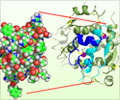Nanoparticles developed by scientists are capable of releasing insulin in the blood and thereby maintains normal blood sugar levels.

The work was done by researchers at North Carolina State University, the University of North Carolina at Chapel Hill, the Massachusetts Institute of Technology and Children's Hospital Boston, reports Science Daily.
"We've created a 'smart' system that is injected into the body and responds to changes in blood sugar by releasing insulin, effectively controlling blood-sugar levels," says Dr. Zhen Gu, lead author of a paper describing the work and an assistant professor in the joint biomedical engineering program at NC State and UNC Chapel Hill.
"We've tested the technology in mice, and one injection was able to maintain blood sugar levels in the normal range for up to 10 days."
The new, injectable nano-network is composed of a mixture containing nanoparticles with a solid core of insulin, modified dextran and glucose oxidase enzymes.
When the enzymes are exposed to high glucose levels they effectively convert glucose into gluconic acid, which breaks down the modified dextran and releases the insulin.
Advertisement
Each of these nanoparticle cores is given either a positively charged or negatively charged biocompatible coating.
Advertisement
Source-IANS















